
Update on Wauwatosa’s Attack: Natural Gardens in Changing Climates
December 17, 2023 | Topics: Issues
By Ed Sternberg
Your calls and letters of support following my September post were a great boon toward saving my natural gardens. Thank you! As your letters to officials mounted, the City of Wauwatosa rescheduled its hearing on my gardens. Your concern, and lots of legal work, have saved my gardens and pocket forest from the city’s threatened “mowing”—at least for now. There is more work to be done.
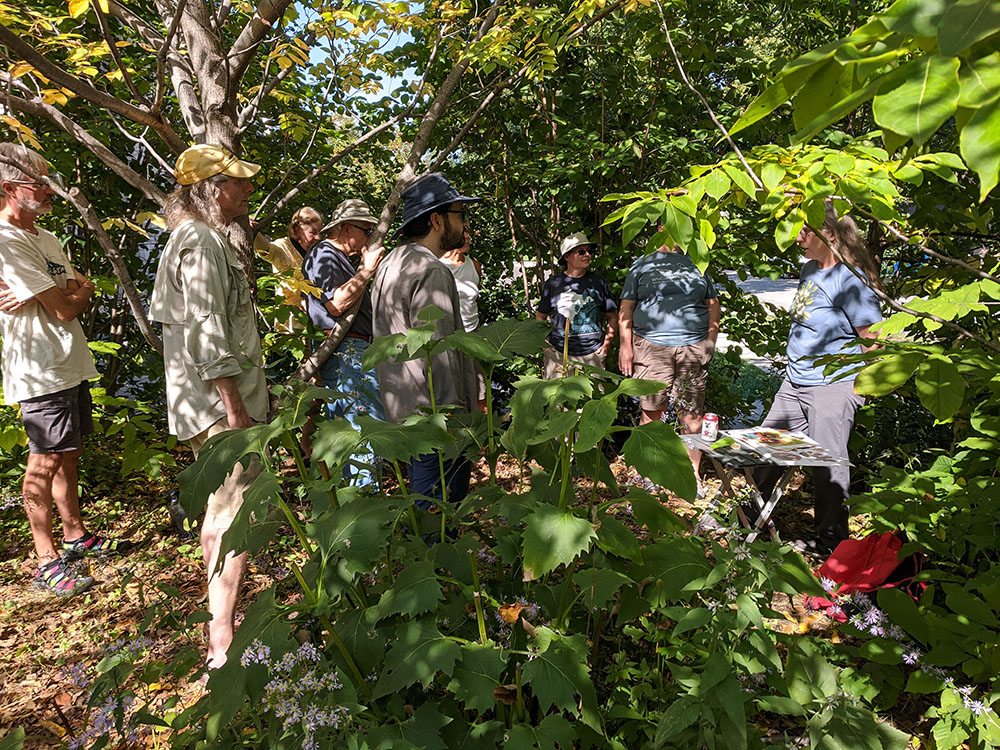
For a second year, the Natural Resources Foundation of Wisconsin (NRF) held a field trip here about urban gardening in a time of climate change (Fig. 1). On October 1, in my pocket forest, Mary Ann Feist and I led the field trip, entitled “Tree Sex and the City: Pawpaws, Pecans, Persimmons, Oh my!” (Ref. 1) Wind-pollinated trees ringing this space were examples of how timing tricks in maturation of separate male and female flowers in various hickory–pecan–walnut family members avoid inbreeding. (Ref. 2) I showed off the first pecan on my newly mature pecan trees; a sharp-eyed trip member spotted another (Fig. 2). Delicious!
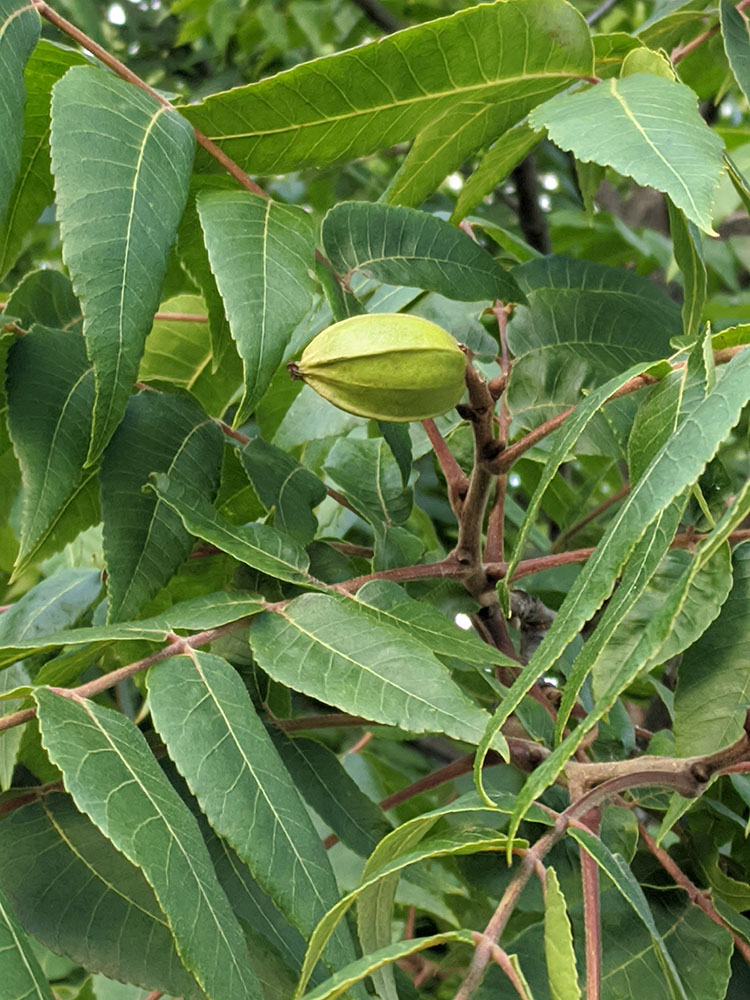
We switched to insect-pollinated trees — pawpaws and persimmons — whose pollination depends on the insects attracted to their flowers. Persimmon trees grown from seed are reported to be seven to one, male to female. (Ref. 3) My few are all male, so only reproduce by suckering (producing new shoots 5 to 25 feet from their base). No persimmons yet. Something not yet known must assure genetic recombination. We’re testing grafting of female twigs to male branches, as well as a few other tricks.
Pawpaws are mostly fly-pollinated. Flies don’t travel far, so pawpaw trees need to be close to each other to get pollinated. (Ref. 4) Pawpaws had great crops this year; field trip members shared in a tasting (below).

With your help, growing natural gardens is safer and easier—and just in time. Climate change is now official. I planted my pawpaws, pecans, persimmons and other trees in 2014, in what was USDA’s Plant Hardiness Zone 5b or 5a (Fig. 4). (Ref. 5) A few weeks ago, the USDA updated these zones. My gardens are now in Zone 6a, roughly 5ºF warmer. Some nearby neighbors are still in zone 5b (Fig. 5). (Ref. 6)
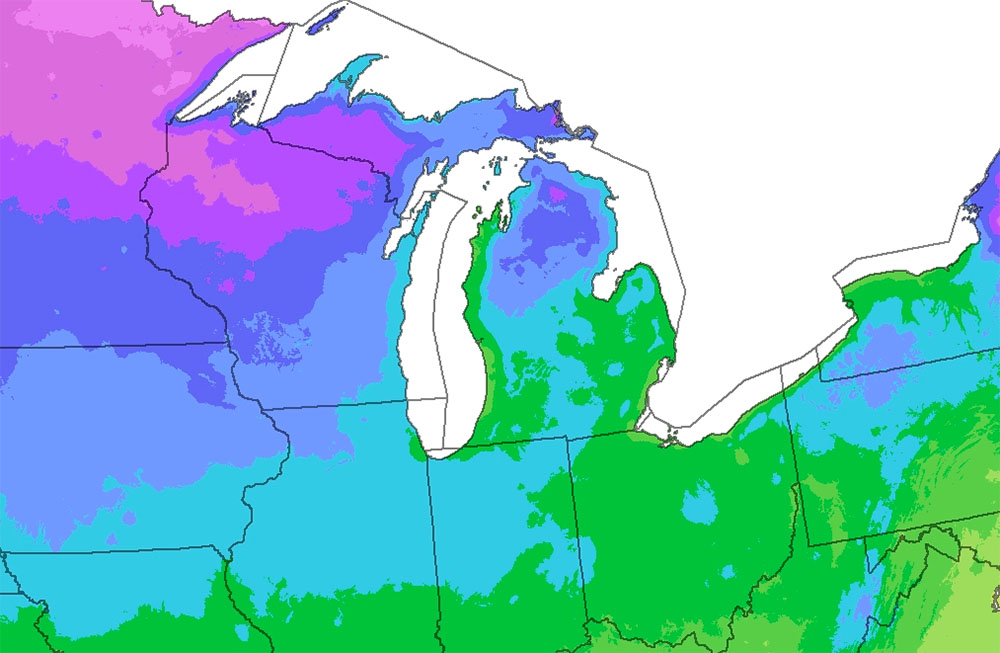
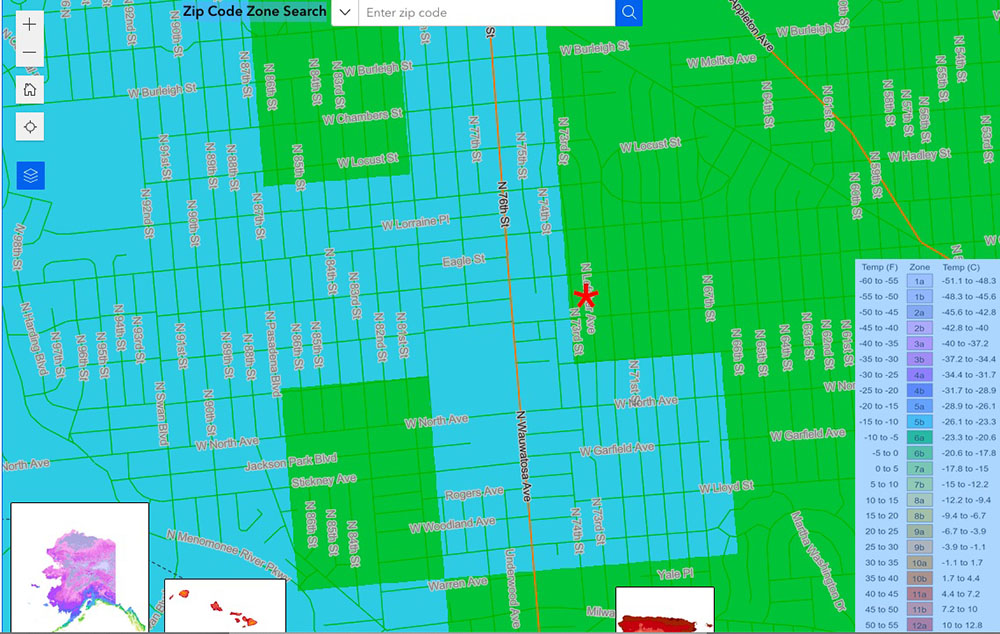
Public Opinion, the Press, and Natural Gardening
The interest of the NRF established that naturalists across Wisconsin value my gardens. But until the city cited my gardens this June, I didn’t know if my neighbors like my gardens. Their letters and your response to my first blog post got the city’s attention and settled the question of public support. One of my alderpersons sent the following email to the city and to me (Ref. 7):
“I am 100% in support of Ed Sternberg keeping his native garden. I have received countless emails and calls from residents all in support and none opposing it. Between now and November I will be reviewing the ordinance to see if we can strengthen the language to ensure Ed has no issues in the future.”
I was tickled by one expression of support this past summer from two neighbor children. Racing their bikes down the street, a boy, about seven years old, shouted to a girl ahead, about six, “Wait! Wait! We forgot to ride through the forest!” They circled back, and as they raced down my sidewalk, they saw me and stopped. I showed them a few plants, nuts, and fruits. Their eyes grew wide. They said, with my ok, they’d be bringing other friends back to see.
Your unanimous support powerfully indicates that natural gardens, already accepted in Wauwatosa law, are also appreciated by nearly all my neighbors. Your support on social media led to interest by newspapers, radio, and television. (Ref. 8) Thanks to Milwaukee Journal Sentinel’s Bridget Fogarty and Ebony Cox, and Margaret Faust at Wisconsin Public Radio, among others, for careful, accurate reports and great photos. Of many interesting interactions with reporters, one stands out as an Aha! moment in natural gardening:
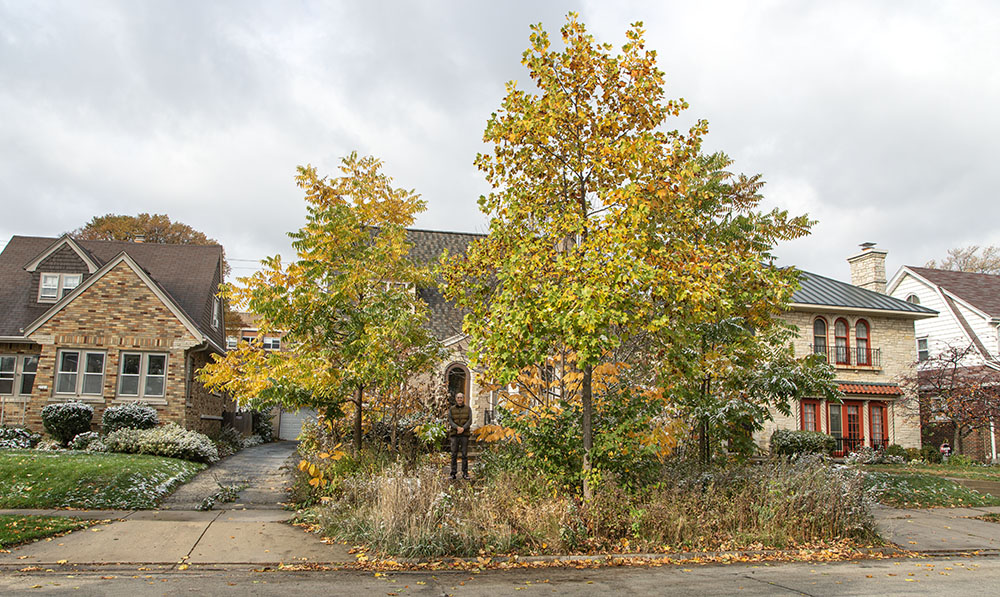
Several reporters asked how many native plant species I’ve planted, but one added this: “How many species are in my gardens?” I replied, what I planted and what’s there now are two different questions. Imported garden plants, if fertile, often lack ecosystem controls. Many are sterile. These act like a still-life, unlike native plants, which in effect dance in a community drama, to the tune of birds, wind, and other pollinators. With friends, I’ve planted nearly 200 native or regional species. But plants die back in adverse conditions, or move by seed, sucker, or chipmunk, as did my wild ginger, Jack-in-the-pulpit, and persimmons. Oaks, walnuts, and hackberry trees appeared as volunteers. Contrasting a traditional garden of sterile cultivars, bereft of pollinators, with the dynamic, yet controlled vitality of a natural garden, seemed to open a window to understanding natural gardens. (Ref. 9)
Why natural gardens? We know they bring nature home to us, yet increasingly, they also are a last refuge for nature itself. How important are our natural gardens as a refuge for nature? Urban private lands are between a third and half of what remains in urban areas for nature (Fogel, Zwarun, et al.). (Ref. 10) About 85% of land potentially available to nature in the U.S. east of the Mississippi is privately owned (Tallamy). (Ref. 11) In Wauwatosa, as developers got control of what was public green space, the fraction of green space in private ownership increased as its total green space shrank. A lot of money is at stake here. Some people will fight dirty to get it. (Ref. 11)
While public support for natural gardens has grown, the reasons we value such gardens are diverse. Some people prefer very short plants like wild ginger, trout lily, or blue mist. Some want birds and/or bees. The birds, the bees, and the plants have their own particular needs, which may be at odds with certain people’s preferences. For example, I planted wild ginger and trout lily in early test gardens. They hang on, or not, because the soil and the habitat don’t yet match their requirements. Blue mist, recently planted, does great, for now.
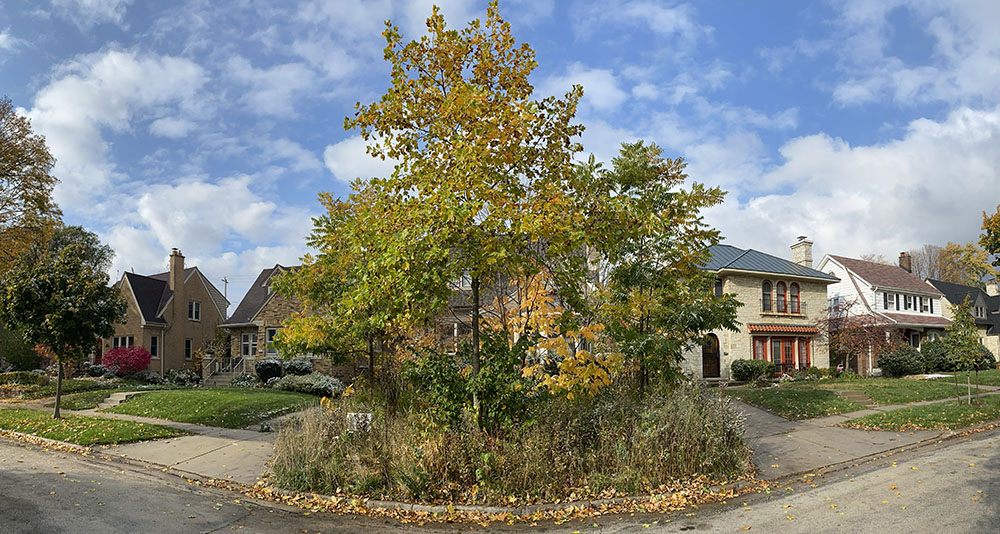
What brings us together in appreciation of natural gardens is our dependence on nature for our food, air, water, and well-being. What holds us together is an intuitive feeling of relaxation and clarity in a natural setting. Harmonizing the individual requirements of our neighbors — human, rooted, or critters — who keep our world going is the fun part of what I do.
City harassment is not fun. The city claims that even the slightest challenge to a natural garden requires city arbitration. Your support shows that claim is backward. Hours after my Sept. 14 post, just days before the Sept. 18 hearing, the city unilaterally rescheduled its planned hearing (Ref. 13) Legal convolutions and large legal fees have followed, with this result:
The city has withdrawn all its original complaints, for now, but invented a new claim — a right to attack certain natural gardens of their choosing without regard to law, increasingly standard practice, practically complete community acceptance, or prior city acceptance. City officials demand that I prepare and submit a landscape plan, which is either a door to more harassment or a fig leaf for accepting what they have already agreed is legal, their forester helped plan, and is widely supported (Ref. 14).

A restoration ecologist and I are developing an improved method of landscape planning for research purposes. If I submit this plan to the city, it will justify their demanding that all of you hoping to (continue to) grow a natural garden pay for your own landscape plan and hope the city approves it. This is crazy. I’ve already accrued over $10,000 in legal fees. It’s difficult to justify more personal expense to protect what is increasingly a purely public interest. I’ve founded a fund, the Natural Gardens Research and Defense Fund (NGRDF), to develop and demonstrate gardens that satisfy both wild and domestic neighbors, and legal protections for at least a few natural gardens from nonsensical and/or illegal attacks. I’ll discuss other people and organizations interested in this work in my next post. If you’d like to contribute to the Natural Gardens Research and Defense Fund, contact me. If you believe, as I do, that we need to protect ourselves and our gardens from such attacks, do let me know, at email <ed@ngrdf.org>, and watch for my next post on this blog.
Related story:
Ed Sternberg’s first post: Native garden comes under attack in Wauwatosa.
References and Notes:
1 Buckley, Cara. 2023. “Tiny Forests With Big Benefits.” The New York Times, Aug 24, sec. Climate. www.nytimes.com/2023/08/24/climate/tiny-forests-climate-miyawaki.html.
If you don’t have a subscription to the New York Times and would like a gift copy of this article, contact me at <ed@ngrdf.org> with your name, phone number, and email; ask for this article, and I will email you a gift link to it. If you’re interested in helping support work like that described in this article, also please email me.
A third co-leader, a meteorologist interested in climate change and native plants, was unable to make this year’s trip. If you’re interested in participating in next year’s trip, scheduled for September 29, 2024, join the Natural Resources Foundation of Wisconsin (www.wisconservation.org/field-trips/). The 2024 Field Trip Guidebook is in preparation.
2 They time the maturation of their separate male catkins and tiny female flowers, so male flowers on one tree infrequently pollinate their sister flowers on the same tree. In the case of butternut trees, this blockade is so weak that only one tree may suffice to get many nuts. Inbreeding in pecan trees seems rarer. In figure 1, behind the trip’s humans, are hazelnut trees and pecan trees. In the early spring, if you look closely at just the right time, hazelnut trees have tiny beautiful purple female flowers that show only stigmas and styles. To the left in the picture is a large butternut tree and a small pawpaw tree. Planted around the same time, but behind the people, is a beech tree, only about two feet tall. This slow growing species could overtop all the others in fifty years, if it survives humans, our climate change, and city actions. A persimmon tree is to the right. Pecans, pawpaws, and an oak are behind the camera.
3 Most persimmon growers report a seven-fold prepoderance of male trees. (Personal communication, president of the North American Fruit Exchange (NAFEX).
4 I did see one swallowtail butterfly attending to pawpaw flowers at the top of one tree once this past year. It was not a zebra swallowtail, which is fairly pawpaw specific but not found yet in Wisconsin. I haven’t yet identified the species of swallowtail I saw, but flowers where it was active produced the largest cluster of pawpaws I’ve yet seen.
5 https://planthardiness.ars.usda.gov/system/files/US_Map_2012.jpg; a more detailed version of this map might be available for several thousand dollars from the USDA’s contractual developer at https://prism.oregonstate.edu/.
6 https://planthardiness.ars.usda.gov/. The odd, discontinuous zone borders might be due to minor topographic features increasing sun and wind exposure on cold winter days.
7 Both emails included a header entry “To:” to the city clerk, and so should be available as open records.
8 If you would like to maximize your impact, consider letting me know of your support directly, at email ed@ngrdf.org.
9 Milwaukee Journal-Sentinel articles, and Wisconsin Public Radio report and broadcast, are:
•• Faust, Margaret, dir. 2023. “Natural Gardens Boxed in by Municipal Codes.” Wisconsin Public Radio. www.wpr.org/wauwatosa-natural-gardens-municipal-codes-ed-sternberg.
•• Fogarty, Bridget. 2023a. “Is Tosa Man’s Yard a Natural Garden or Code Violation? Wauwatosa Officials Will Discuss.” Journal Sentinel, Oct 20. www.jsonline.com/story/communities/north/2023/10/20/wauwatosa-homes-natural-gardens-raise-questions-about-code/71221411007/.
•• ———. 2023b. “Tosa Officials Won’t Discuss Resident’s Natural Garden without Proper Application.” Journal Sentinel, Nov 7. www.jsonline.com/story/communities/north/2023/11/07/wauwatosa-officials-wont-discuss-a-residents-n-gardens-the-city-threatened-to-mow-earlier-this-year/71441218007/.
Journal-Sentinel articles may be behind a paywall. I’ve asked the Journal-Sentinel and Gannett to enable gift articles. If Gannett and the Milwaukee Journal-Sentinel create a system for gifting articles, I’ll email gift links to those who ask.
10 Fogel, Nina S., Lara Zwarun, Cody D. Schrock, and Gerardo R. Camilo. 2023. “A Survey of American Residential Garden Conservation Programs.” Journal of Urban Ecology 9 (1). doi.org/10.1093/jue/juad017.
11 Prof. Tallamy’s recent presentation to an Eau Claire chapter of the Sierra Club is a superb introduction to urban ecology (L.E. Phillips Memorial Public Library, dir. 2023. Douglas Tallamy | Chippewa Valley Book Festival. www.youtube.com/watch?v=t0NV0FK1D5M). The value of about 85% is given at 14:32 m:s. Prof. Tallamy wanted to attend the hearing scheduled for Sept. 18 on my behalf. I value his support. He is a founder of Homegrown National Park (https://homegrownnationalpark.org/).
12 As best as I can tell, the long-term value of green space for residents and homeowners is, for developers, only a short-term opportunity for private gain, as profit or marketing. Decide for yourself whether these books provide useful context:
•• Chayes, Sarah. 2020. On Corruption in America: And What Is at Stake. 1st edition. New York: Alfred A. Knopf.
•• Teachout, Zephyr. 2014. Corruption in America: From Benjamin Franklin’s Snuff Box to Citizens United. Cambridge, Massachusetts: Harvard University Press.
13 The city obstructed my neighbor, Dr. Weis, from attending that hearing by its action on four days’ notice to unilaterally reschedule its Sept. 18 hearing to November. Dr. Weis had rescheduled his patients so he could testify. The city’s delay for over a month seems to violate WMC 15.32.060.E.1, which states “the Board is required to hold a hearing within 15 days of an appeal.”
14 We sought judicial review to affirm the illegality of the city’s acts. The city, twice, so far, withdrew its legal proceedings rather than face judgement, while leaving its defamatory origins on their records, and deleting its records of the city’s acceptance of these gardens. As Preet Bahara recently published, such processes are unjust, and should end. (Bharara, Preet. 2023. “The Legal Double Standard That’s Rarely Discussed.” NY Times, Nov. 12. www.nytimes.com/2023/11/12/opinion/preet-bharara-prosecutors-investigations.html).
All images courtesy of the author, except as noted. The banner photo at the top is by Eddee Daniel. Ed Steinberg is a resident of Wauwatosa.
2 thoughts on "Update on Wauwatosa’s Attack: Natural Gardens in Changing Climates"
Comments are closed.


Beautiful! I would encourage more of it and would ask the parks to look into planting some of these in areas were poplar trees along the the Oak Ridge trails have been lost.
A reduction in chemicals used to control weeds would also benefit our overall environment.
Ed Sternberg’s article was fascinating. His garden is an asset to Wauwatosa.
I would hope our city leaders will not pursue any further action on this issue.